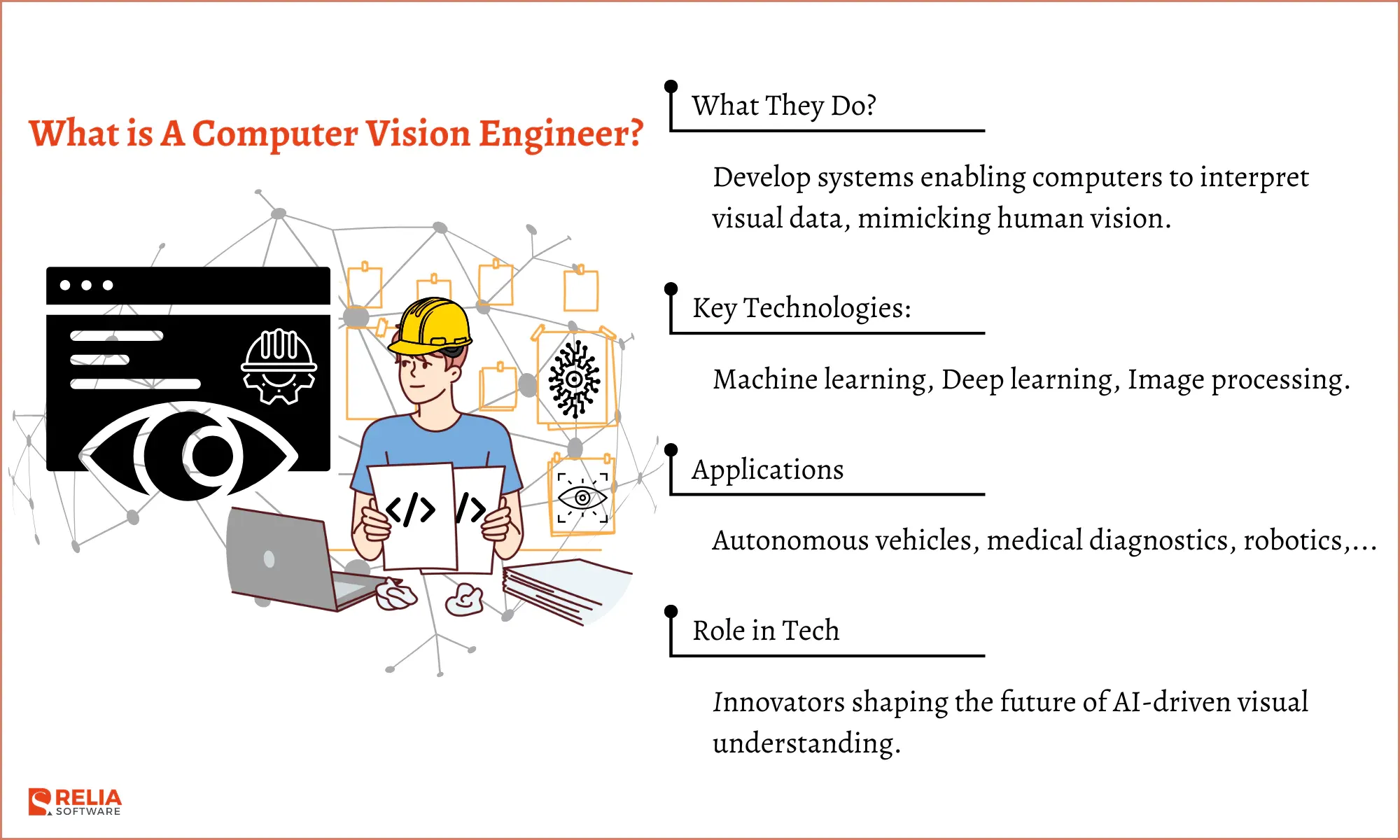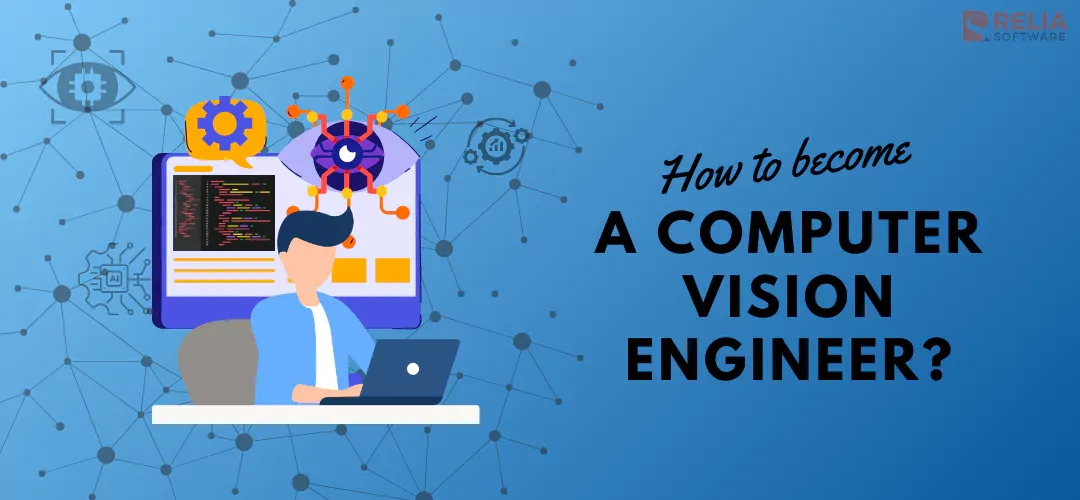Computer vision engineering combines artificial intelligence and machine learning. They work with visual data in a variety of formats, including video feeds, digital signals, and analog images that the computer digitizes.
A computer vision engineer has to help computers "see" by implementing deep/machine learning and mathematical structures in code. Specifically, what does a computer vision engineer do? Let's explore the requirements, skills, and guide to becoming a computer engineer in this blog.
What is A Computer Vision Engineer?
A computer vision engineer is a specialized professional who works at the convergence of computer science, machine learning, and image processing. They are responsible for creating algorithms and systems that allow computers to interpret and comprehend visual input from the environment around them, similar to human vision.
These engineers use advanced deep learning and artificial intelligence approaches to create novel solutions that allow computers to recognize patterns, make decisions, and interact with their surroundings based on visual inputs.
Computer vision engineers, as architects of the digital eye, play a critical role in determining the future of technology, contributing to advances in domains such as driverless vehicles, medical diagnostics, and beyond.

Job Description of Computer Vision Engineer
A computer vision engineer's work is as diverse as the circumstances in which computer vision is used. However, there are a few general jobs that most computer vision engineers will frequently perform:
- Develop computer vision algorithms and systems that process, analyze, and interpret visual data.
- Identifying patterns, forms, and characteristics in photos and movies using image processing and object detection.
- Modeling image classification, recognition, and automated decision-making with machine learning.
- Performance optimization of computer vision code and methods, including real-time processing.
- Working with software developers and data scientists to integrate computer vision technology into systems and applications.
- Researching and following computer vision, machine learning, and AI developments.
- Verifying computer vision models and systems' accuracy and reliability.
- Create and maintain computer vision system design requirements and user guides.
- Ensure computer vision systems meet industry data privacy and security standards.
- Helping deploy computer vision programs with technical issues.
- Working with stakeholders to transform business needs into technological specifications.
- Performing code reviews, sharing information, and teaching junior engineers computer vision best practices.
Requirements of Becoming A Computer Vision Engineer
Technical Skills
For Entry-level Computer Vision Engineer
Beginning computer vision programming in Python or C++ and understanding image processing, pattern recognition, and machine learning methods should be top priorities for engineers.
OpenCV, TensorFlow, and PyTorch knowledge are also crucial. Fundamental skills are needed to analyze and interpret visual data and construct fundamental computer vision applications. Entry-level engineers should also learn to solve problems and work in teams using Git.
For Mid-level Computer Vision Engineer
Mid-level computer vision engineers need the technical ability to handle more complex projects and supervise. This includes understanding and applying advanced machine learning approaches like deep learning and neural networks to real-world issues.
A solid grasp of data annotation, dataset development, and model training is also crucial. Project management and communicating technical concepts to non-technical stakeholders become more important. Mid-level engineers must be skilled at code optimization and system integration to deploy computer vision applications efficiently.
Senior Computer Vision Engineer Essential Skills
Senior computer vision engineers must be strategic and innovative leaders. They should know the newest advances in the field, such as generative AI models and reinforcement learning, and how to use them to solve business problems.
Senior engineers must mentor junior engineers and coordinate cross-functional collaboration as they lead research and development teams. In these cases, familiarity with mentoring software can also be valuable, helping them structure learning pathways and track the growth of less experienced team members.
They must also handle stakeholders well, define project goals, and make crucial decisions that support the company's long-term goals. Senior engineers should promote AI best practices and ethics to ethically build and deploy computer vision technology.
Here is the summary of essential skills for computer vision engineer by experience:
Level | Required Skills |
Entry-level | Programming language (Python, C++) Image Processing Algorithms Pattern Recognition Algorithms Machine Learning Fundamentals OpenCV, TensorFlow, or PyTorch Problem-Solving Abilities Teamwork & Version Control (Git) |
Mid-level | Advanced Machine Learning (Deep Learning, Neural Networks) Real-world Problem-solving with Machine Learning Data Annotation & Dataset Creation Model Training Expertise Project Management Technical Communication Code Optimization & System Integration |
Senior | Strategic Mindset & Innovation Leadership Latest Advancements in Computer Vision (Generative Models, Reinforcement Learning) Business Problem-solving with CV Technologies Leading R&D Teams & Mentoring Cross-functional Collaboration Stakeholder Management & Project Vision Ethical AI Considerations & Best Practices |
Underrated Required Skills for Computer Vision Engineer
Some underrated abilities are essential for computer vision engineering's subtle problems and imaginative work. Such as:
- Domain Knowledge: Knowing the computer vision domain well can shift the game. When building medical imaging systems, knowledge of healthcare protocols helps engineers customize algorithms to clinical needs and regulatory norms.
- Data Cleaning and Annotation: The tedious task of cleaning and annotating data sets is typically overlooked by the more glamorous modeling phase, yet it is essential for computer vision projects. High-quality, well-annotated data improves models and speeds up algorithm debugging and refinement.
- Interdisciplinary Collaboration: Computer vision requires cross-disciplinary collaboration, which is rarely highlighted. Engineers who work with psychology experts to understand human visual perception might develop more innovative and effective solutions.
>> Read more:
- 12 Essential Technical & Soft Skills for UX Designers
- Web Development Skills To Become A Good Web Developer
Essential Qualifications
Since this job requires a lot of technical knowledge, you still need a good educational background to get in. The underlying knowledge, specialized abilities, and recognized credentials of a degree might be useful in a competitive employment market.
Here are the typical degrees of computer vision engineers, showing their broad yet concentrated academic routes that help them design systems that allow computers to analyze digital images and movies.
Computer Science or Computer Engineering
A degree in computer science or engineering is a frequent and relevant foundation for computer vision careers. Complex computer vision systems require a profound understanding of algorithms, machine learning, data structures, and programming. This foundation prepares graduates to confront technological issues like algorithm creation and software implementation.
Electrical Engineering
Computer vision image analysis requires signal processing, which electrical engineering degrees address. Professionals with this experience can create and optimize computer vision algorithms and hardware because they understand how to handle and interpret digital imaging sensor data.
Statistics or Applied Maths
Visual data interpretation in computer vision relies on mathematical models and statistical analysis. Applied mathematics or statistics degrees provide strong quantitative training for building computer vision algorithms. The field relies on pattern recognition, geometric modeling, and probabilistic analysis, which these experts excel at.
Robotics
Computer vision is essential to robotic perception and navigation, hence robotics degrees generally incorporate it. Graduates of these programs can integrate vision systems into larger robotic systems to enable complex machine-environment interaction.
Machine Learning & AI
Deep learning has made Machine Learning and AI degrees relevant to computer vision. These programs focus on neural networks, deep learning architectures, and other cutting-edge AI methods for computer vision research and application development.
Experts in this field can build systems that learn and improve their visual recognition. Understanding these frequent academic pathways will assist job seekers in determining computer vision engineering's most desirable talents and knowledge. While distinct, each degree path brings a unique perspective and skill set that advances computer vision technologies.
>> Read more:
- Top 10 Best AI Development Tools for Software Developers
- Top 17 Best AI Apps For Individuals and Businesses
- Top 12 Best Free AI Chatbots for Businesses
- Top 9 Best Deep Learning Frameworks for All Levels Developers
- Will AI Replace Software Engineers Altogether? Here's the Truth
4 Steps To Become A Computer Vision Engineer
Educational Pathway
Computer vision engineers must have a solid computer science foundation. Programming languages, algorithms, data structures, and mathematics (particularly linear algebra and calculus) are covered in a bachelor of computer science, electrical engineering, or related field. Specialized computer vision courses at many universities can give you an edge. Online courses and MOOCs like Coursera and edX can augment your study or be a starting point for a career change.
Skill Development
After mastering the basics, practice computer vision skills. Python and C++ are the main languages for building and manipulating computer vision applications. Train and deploy strong computer vision models with deep learning frameworks like TensorFlow and PyTorch. Knowing popular computer vision libraries like OpenCV will give you pre-built functions and methods for image processing and computer vision.
Building Your Portfolio
To get your dream job, you need a good computer vision portfolio. Use public datasets for object identification or image classification to start. Build more difficult applications like facial recognition or self-driving car simulations as you learn. Online challenges like Kaggle tournaments are great for testing your skills and dealing with real-world datasets. Show potential employers your work on GitHub to demonstrate your coding style.
Landing Your First Job
You have an excellent computer science basis, technological capabilities, and a strong portfolio. Now turn your efforts into a rewarding career. Here's how to find your dream computer vision engineer job:
- Create a Strong Resume and Cover Letter: Use job descriptions' keywords to emphasize abilities and experiences on your resume. Show your expertise in relevant programming languages, deep learning frameworks, and computer vision libraries. Personalize your cover letter to reflect your excitement for computer vision and the company or project.
- Technical Interview Preparation: Technical questions and coding problems are common in computer vision engineering interviews. Practice computer vision tasks like object identification, image segmentation, and image classification. Learn typical computer vision deep learning architectures.
- Finding Jobs: Use Indeed, LinkedIn, and Glassdoor to find computer vision engineer jobs. Join online communities, meetups, or conferences to meet industry professionals. Directly contact recruiters or hiring managers to show your interest in their organization.
You may succeed in the ever-changing profession of computer vision engineering by following these steps and improving your skills.

>> Read more:
- Detailed Roadmap To Become A Full-Stack Developer
- Roadmap To Become A Machine Learning Engineer
- What Does A Python Developer Do? & How To Become A Python Developer?
Salary Of Computer Vision Engineers
As of Apr 9, 2024, the average US Computer Vision Engineer salary is $121,515. A simple pay calculation shows $58.42 an hour. This equals $2,336/week or $10,126/month.
While ZipRecruiter reports annual salaries as high as $137,500 and as low as $48,500, most Computer Vision Engineers earn between $111,500 and $131,500. The average earning is little, suggesting that even with years of expertise, there are few chances for higher compensation.
Few organizations are hiring Computer Vision Engineers in Ho Chi Minh City, VN, and around the world, according to ZipRecruiter. Here is the table of computer vision engineers' salaries by countries that you may refer to:
Country | Annual Paid Range (USD) |
America | $115,000 - $200,000 |
England | $60,000 - $110,000 |
Singapore | $62,000 - $120,000 |
Vietnam | $5,000 - $25,000 |
Australia | $70,000 - $120,000 |
India | $10,000 - $30,000 |
>> Read more:
- What is the DevOps Engineer Salary in Vietnam?
- An In-depth Look at Web Developer Salaries in Vietnam
- Python Developer Salary Worldwide
Conclusion
Computer vision and visual AI will continue to demand computer vision engineering specialists. Technology like Edge AI and AIoT makes computer vision widely available. Thus, new use cases are possible in many industries, including healthcare, pharmaceuticals, logistics, sports and fitness, and smart cities.
Hope that this blog has informed you of the vocational guidance about how to become a professional computer vision engineer.
>>> Follow and Contact Relia Software for more information!
- development

